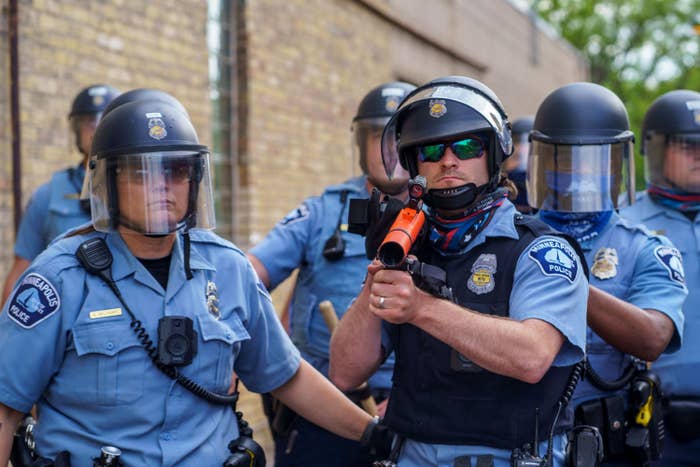"While Black people in Minneapolis have been reduced to bottom caste status, white communities have thrived.”
Posted on May 29, 2020,


Kerem Yucel / Getty ImagesA police officer aims a projectile weapon at protesters in Minneapolis.
The death of George Floyd has put the Minneapolis police force in the global spotlight and led to an officer being charged with his murder. There are deep underlying tensions in the way the city polices its residents; Minneapolis spends a much larger share of its budget on policing than many other large US cities do, with services like health and community development taking a backseat to salaries for law enforcement.
The city spent more than one-third of its discretionary budget on policing in 2017, according to a study published by Popular Democracy. That’s a larger share than all but 2 of the 10 cities studied in the report. For every dollar Minneapolis spent on police that year, it spent just three cents on youth training and development, the authors found.
Here’s how much each of the 10 cities devoted to police from their general funds — the part of a city’s overall budget that leaders can spend at their discretion.
Those priorities are still in place today. For 2020, Minneapolis Mayor Jacob Frey announced a budget that would allocate $193 million to the city’s police department. This is 60% more than the $120 million devoted to the city’s Community Planning & Economic Development Department, which is responsible for things like affordable housing and job training for residents making low incomes.
Here’s where police spending sat within the overall 2020 Minneapolis budget, which includes both its general fund and mandatory spending.
In return for all that spending, Minneapolis residents get a police department that paid out $9.3 million to settle police misconduct lawsuits in a recent three-year stretch — millions more than was spent during a similar period in Baltimore, a city roughly 40% larger. In 2014, the ACLU reprimanded the department for over-policing black people, reporting that they were 11 and a half times more likely to be arrested for marijuana possession than white people were. And the city has historically failed to remove and discipline bad police officers. Derek Chauvin, the officer who was charged with murder today, previously had 17 complaints filed against him, 16 of which resulted in no disciplinary action.
Residents have been very vocal about spending on the police force taking priority over other programs, and that conflict was particularly acute in negotiations for this year’s budget. City leaders were successfully pressured to more than double the number of police hires, with the increased spending to be paid for with a property tax hike. The Minneapolis Star Tribune reported the hike will be “felt most acutely in less wealthy pockets of the city, where property taxes are expected to rise more than 20% next year.”
More money was also allocated to violence prevention programs, but residents expressed fury at the boost in police spending. “If policing was going to help our problem, it would have happened by now,” Mysnikol Miller told the Star Tribune. “We have had plenty of police for plenty of years, and it’s not improving anything.”
Local activists interrupted a press conference where Frey discussed the boost in police spending, MinnPost reported. “Creating more cadets brings more police officers on the streets, more harm into our communities, less investment in community-led violence prevention,” said Sheila Nezhad of Reclaim the Block.
Other activists point out that combating crime requires investment into the community itself. A recent study of census data ranked the Minneapolis, St. Paul, and Bloomington metropolitan area as the fourth-worst place in the country for black people to live. The median income of black residents was just 43.4% of that of white residents (nationally, that number is about 61%), and homeownership among black people was 25.4% versus 75.3% for white residents (on a national level, that's 44% versus 73%).
“Policing is a byproduct of larger, more insidious, but often less visible systems. [...] We know that when we see aggressive policing practices — behind it are the most brutal forms of economic and social inequality," wrote Yeshimabeit Milner, the executive director of Data for Black Lives, a coalition of researchers and activists.
“While Black people in Minneapolis have been reduced to bottom caste status, white communities have thrived.”
 Lam Thuy Vo is a reporter for BuzzFeed News and is based in New York.
Lam Thuy Vo is a reporter for BuzzFeed News and is based in New York.
No comments:
Post a Comment